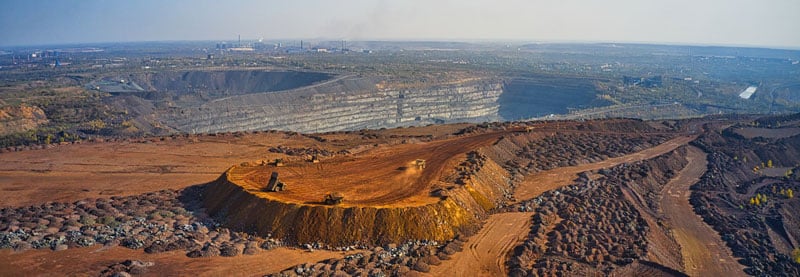From the heart of the Sierra Madre Occidental mountain to the buzzing trade hubs of Mexico City, the quest for gold has been a part of Mexico’s rich tapestry for over 500 years.
While tales of golden fortunes and monumental discoveries may sound like legends from a bygone era, the truth is, Mexico’s gold veins are far from tapped out.
In fact, beneath its terracotta soil lies potential that continues to dazzle investors and transform the global mining landscape.
Join us as we delve into the lustrous history, current state, and promising future of gold mining in Mexico.
Key Takeaways:
- Gold Production in Mexico: Mexico has been a prolific producer of precious metals for more than 500 years; over 10 billion ounces of silver mined and nearly 40 million ounces of gold in total.
- Mexico Gold Mining Industry: Mexico’s centuries-old mining industry is one of the largest in the world for foreign direct investments (FDI) at $1.6 billion in 2022.
- Mexico Gold Mining M&A: The Mexico mining sector remains the leader in M&A activity, with 151 announced transactions in 2022 valued at a total of $14.7 billion.
- Finding Gold in Mexico: Search carefully for the presence of quartz veins, limonite, calcite and adularia, and rocks with textural and mineralogical evidence for the past presence of metalliferous fluids. Where these elements are abundant, gold is frequently close by.
- Mexico Gold Mining Jurisdiction: Mexican mining companies may be 100% owned by foreign investors, and have the same rights as a Mexican doing business.
- Mexico Gold Mining Politics: Investing in gold mining in Mexico presents a myriad of political challenges, including controversial reforms plus land and permit issues.
How Much Gold Is There In Mexico?
For more than 500 years, Mexico has been a prolific producer of precious metals; over 10 billion ounces of silver mined and nearly 40 million ounces of gold in total.
At the current gold price, this amounts to 1,297,936,353,863.08 Mexican Pesos.
How Big is the Mexico Gold Mining Industry?
At the time of publishing, nine of the ten largest active gold mines are located outside North America (Indonesia, Uzbekistan, Russia, Australia, DR Congo, the Dominican Republic and Papua New Guinea).
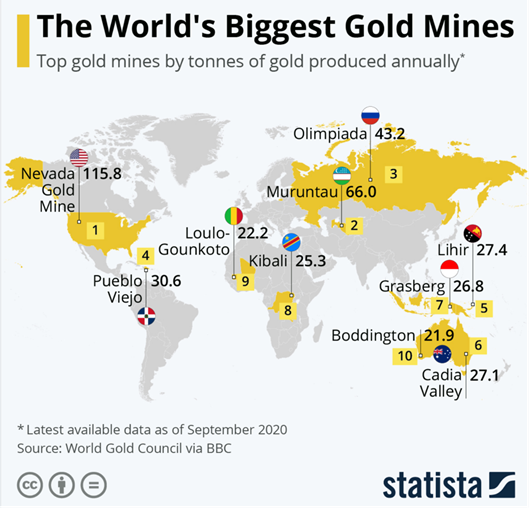
The world’s biggest gold mines by country. Source: Statista
However, big gold mines are increasingly becoming old gold mines; The most productive mines were all discovered decades ago:
- 1958 – Muruntau Gold Mine in Uzbekistan. The world’s second biggest gold deposit is also the world’s largest open-pit gold mine. It produces around 66 tons (approx. 2,121,949 troy ounces) annually, after being discovered in 1958.
- 1961 – Nevada’s gold mines produce around 116 tons (approx. 3,729,456 troy ounces) every year – comfortably the highest global total. The Carlin trend is a large, low-grade deposit, discovered in 1961.
- 1975 – The Olimpiada gold deposit in Russia was discovered in 1975 and its output is the third-largest worldwide with 43.2 tons (approx. 1,382,482 troy ounces) each year.
Mexico is historically a gold rich region. It has an older mining industry than the US (where mining primary deposits started in the late 19th century).
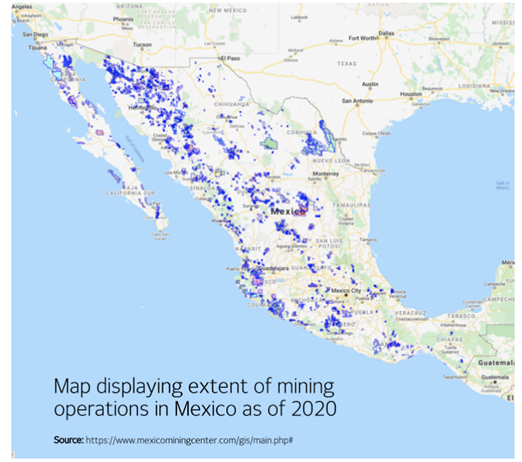
Map of mining operations in Mexico as of 2020
Mexico’s centuries-old mining industry is one of the largest in the world for foreign direct investments (FDI) at $1.6 billion in 2022 (27,285,120,000 Mexican peso). As such, it’s an important part of the economy, promising existing infrastructure to new companies.
That same year, total gold production was reported at 120 million kg, with the industry supporting millions of jobs directly and indirectly.
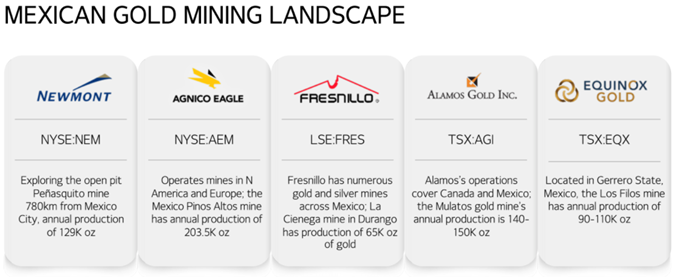
Some of the largest gold mining companies in Mexico
According to Mining Technology, the five largest gold mines in in Mexico are:
- Penasquito Mine.
- El Limon-Guajes Project.
- Herradura Mine.
- Mulatos Mine
- El Coronel Mine
Annual Mexican gold production has dipped in recent years from a high of 132,413 kilograms (approximately 4,257,176 troy ounces) in 2015. This is in part, to historic underdevelopment of Mexico’s industry and the ‘bust’ phase of the gold mining cycle.
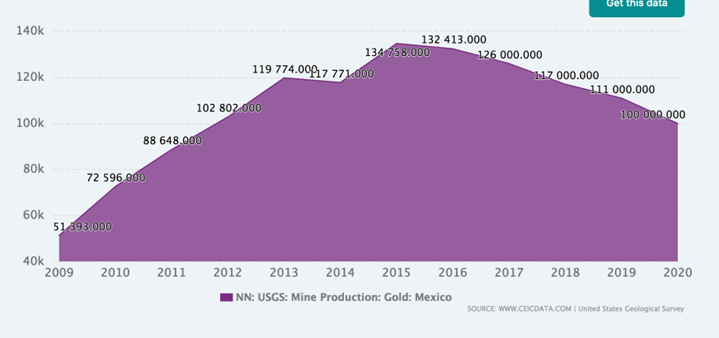
Mexican gold production from 2009 to 2020. Source
However, the region remains one of the most attractive investment opportunities for investors.
The fact is that great natural wealth remains untapped and unexplored in Mexico – with estimates that 70% of Mexico’s surface area has impressive geological potential for mining.
Potential vast mineral deposits are a key reason Mexico became the world’s fourth largest foreign direct investment (FDI) destination for mining, and the premier destination for all FDI in Latin America.
How Mexico’s Gold Mining Industry Works
For those unfamiliar with investing in exploration opportunities, the three-step process for building shareholder value is simple: “Find it. Define it. Develop it.”
Stage 1: Find It
It’s not just about finding gold, but finding the best, fastest, least expensive way to get the gold.
According to Steve Weiss, Durango Gold’s Chief Geologist:
“If you’re an exploration manager, the way you get graded by your boss is by finding the most ounces with the fewest number of feet of drilling. So a really successful exploration program doesn’t just hit the gold – it’s with the fewest number of holes possible and the fewest number of dollars spent doing that.”
Stage 2: Define It
Once the deposit is discovered, now it’s time to figure out how much gold potentially lies beneath the surface.
According to Weiss…
We want to define the size and shape of the “treasure chest” and how many tons of gold/silver are in there, and what the average grade is.
Next, it’s time to define the lateral and vertical extent of the deposit, define the average grade, and determine whether or not it has enough metal value to justify sinking a shaft or digging a big open pit.
Then, it’s time for the moment investors have been waiting for…
Stage 3. Develop It!
As the project progresses – and ounces of gold are accumulated – value is unlocked and valuation goes up.
Once the team has confirmation on the reserves, now it’s time to start digging…
And as more gold is pulled out of the ground – and then sold on the market – the company generates new cashflow. Or, the asset can be sold for a hefty sum of money to another mining company.

Mergers & Acquisitions in Mexico Gold Mining
In an early 2021 report Bank of America (BofA) stated they believe M&A deals have become a shortcut for major gold miners who desperately need to replace more than 50 million ounces of reserves in 2021.
BofA believes the need to replace gold reserves means the M&A market will be a seller’s market this year, with majors desperate for world class assets,
BofA also sees attempts at ‘desktop analysis’ of potential targets to become standard and replace ‘boots on the ground’ due diligence site visits.
This will likely serve as a catalyst for even more mergers and acquisitions, as gold “exploration” conducted from office desktops has contributed to the huge problem majors are trying to buy their way out of.
The Mexico mining sector remains the leader in M&A activity, with 151 announced transactions in 2022 valued at a total of $14.7 billion.
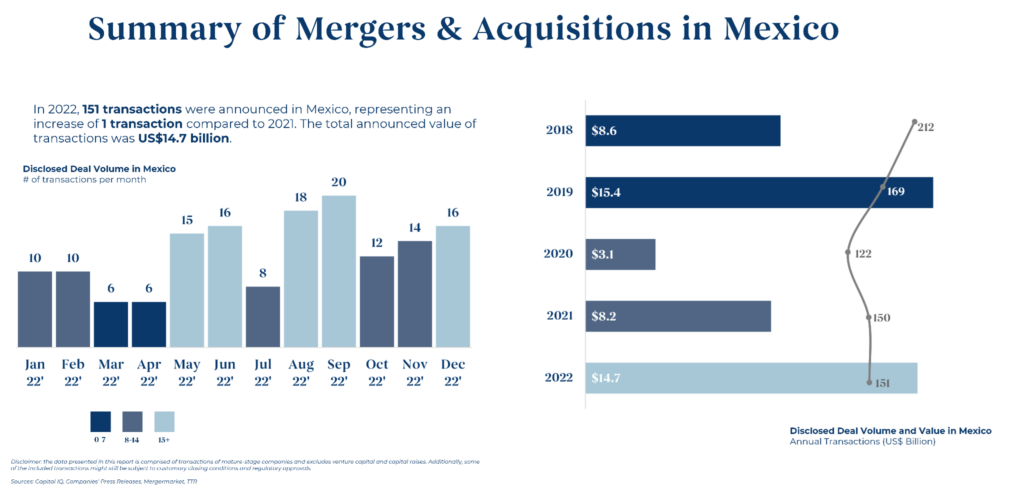
Mexican gold mining mergers and acquisitions by transaction value. Source S&P Capital IQ
Some other notable Mexico-based gold mining M&A activity:
- Mexican Junior gold company Magna Gold acquired the San Francisco mine (in MExico) Magna bought the resource from Timmins Gold, a subsidiary of Alio Gold
- Southern Silver Exploration, a Canadian mining exploration company announced the acquisition of the Cerro las Minitas Project, an asset comprising silver deposits, for US$15 million
- In April 2020, Midland Exploration, a Canadian mining company announced the acquisition of 23 claim blocks in Mexico for an undisclosed amount
- Bank of America listed Mexico’s Torex gold on a list of top potential junior mining targets with “intriguing assets”
Where Can Gold Be Found in Mexico?
One specific region—the Sierra Madre Occidental mountain—has one of the richest histories of precious metal discoveries in Mexico – where mines such as Tio Tita and San Dimas have operated continuously since the 1600s. The mines are clustered around Sonara and Durango in a region known as Mexico’s ‘gold belt’.
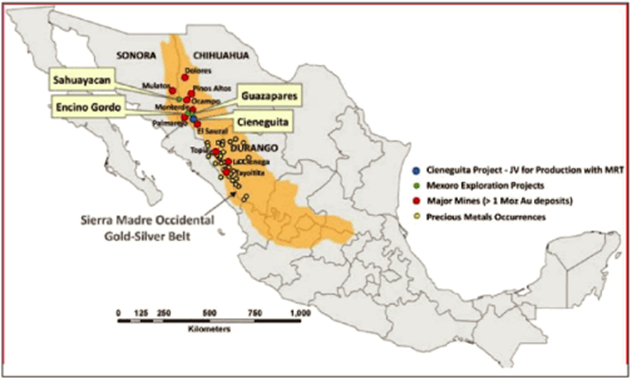
Map of the Sierra Madre Occidental
This mountain range was made famous outside Mexico and forever connected to the idea of gold in the 1948 Hollywood classic ‘Treasure of the Sierra Madre’ starring Humphrey Bogart.
Inside this region in the State of Durango are 121 recorded mines. Today, there are at least five major mining operations in Durango on the western side of the Sierra Madre.
But across this mountain range to the east, nestled in some of the rockiest terrain in the region, lies a potential hidden gem. It’s called the Claudia Project.
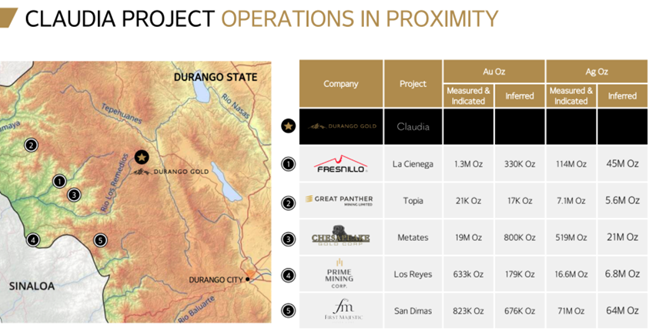
A world-class deposit and several profitable mines sit just downstream of The Claudia Project.
And according to some gold explorers, beneath this rocky terrain could lie a literal “mother lode” of gold. An undiscovered gold-silver deposit of the legacy class, which is a deposit capable of sustaining profitable production for decades.
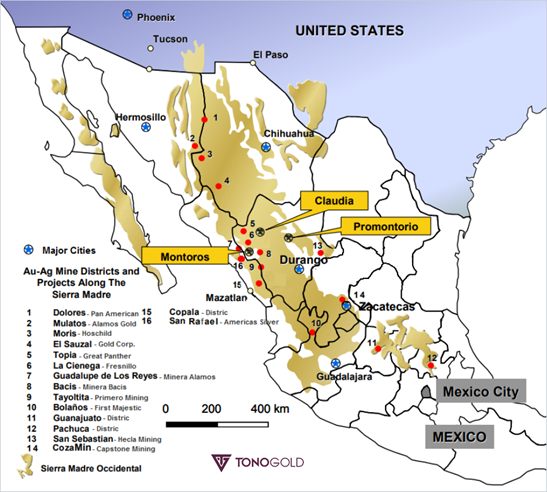
A map showing mines and potential projects clustered around Durango,
near the Claudia project. Source
Other notable precious metal mines and prospects in the area are:
- Fresnillo’s La Cienega (mine in production)
- Great Panther’s Topia (mine in production)
- Capstone’s Cozamin (mine in production – mostly copper )
- Minero Bacis’ Bacis (mine in production)
- Gold Corp’s El Suazal
- First Majestic’s Bolaños
That’s why geologists see potential for discoveries of world-class deposits in this region.
Throughout the history of gold-mining – and Mexican gold mining in particular – there has been an ongoing pattern of major prizes sitting idle, unexplored and underdeveloped.
One cause is that small scale miners are often focussed heavily on cash flow. As a result, they often lack the capital required to fund longer term exploration efforts the industry desperately needs.
The Claudia project shows potential to end Mexico’s long cycle of missed opportunities, and become a world-class deposit.
The small Aguilaréna district around Claudia is full of what Durango’s Gold’s Chief Geologist Steve Weiss describes as ‘Hidden Gems … Long lost mines that locals worked from the 1800s. Each had their own little piece of ground, but lacked the resources to really figure it out.’
How to Find Gold in Mexico
When it comes to developing underground veins of ore — and getting metal out of the ground — high-tech solutions have made the process easier, simpler, and cheaper.
But when it comes to figuring out where to drill in the first place, the answer is astonishingly simple and low-tech.
Look at the ground.
More specifically, search carefully for the presence of quartz veins, limonite, calcite and adularia, and rocks with textural and mineralogical evidence for the past presence of metalliferous fluids.
Fragments of rocks with these characteristics are usually strewn about the surface if there’s a rich vein underneath. Then samples from these fragments are collected and sent for assays in a laboratory. Elements such as silver, arsenic, mercury, antimony and sometimes copper can be used as pathfinders to underlying gold deposits or veins.
Where these elements are abundant, gold is frequently close by.
Is Mexico a Good Mining Jurisdiction?
Mexico is extremely wealthy in minerals, but also relatively unexplored and underdeveloped.
This is partly due to slower economic development before the 1990s, when the Mexican Mining Law – which regulates all mining activity in Mexico and covers the use, expiration and cancellation of mining concessions – was enacted to encourage Foreign Direct Investment into Mexico’s mining and other industries.
Under these laws, all minerals found under Mexican soil are owned by the nation, but private parties may exploit these minerals (except oil and nuclear fuel minerals) through concessions granted by the federal government.
Mexico’s Concession System:
Mexican mining companies may be 100% owned by foreign investors, which can be either individuals or entities. Mexican mining companies that are 100% (or less) owned by foreigners are considered Mexican entities and have the same rights as a Mexican doing business
Exploitation of minerals has been given preference over other uses of land; The law permits up to 100% private ownership in exploration, development and production of minerals.
Exploration and extraction of mineral resources requires government issued concessions. Concession holders are also legally required to negotiate with surface land owners to access resources beneath.
Concessions are issued in three categories, with different time spans:
- Exploration concessions are granted for six years (not renewable).
- Mining concessions are not time-limited.
- Production concessions are granted for 50 years and can be renewed.
All concessions may specify levels of capital expenditure, as well as minimum environmental, health and safety standards.
The tangible benefits of these new laws were to:
- Remove restrictions on foreign ownership of Mexican mining companies and resources
- Revoke mining-specific royalties and taxes
- Simplify the complex web of mining regulations
This brought a wave of investment into the Mexican mining industry, and as a result, private investment became a driving force in the Mexican economy.
The new laws stated that international mining companies had to:
- be incorporated under the laws of Mexico
- state exploration or exploitation of minerals as their corporate purpose, and
- establish their corporate domicile within Mexico.
Coupled with a stable political structure and a skilled workforce, Mexico quickly emerged as one of the leading investment destinations for mining companies.
Gold Mining Police:
Despite Mexico’s vast mining potential, the region has been affected by well-publicized violence and illegal gold mining.
These factors could reduce confidence and hinder the development of Mexico’s mining industry.
However, President Andrés Manuel López Obrador (commonly known as AMLO) has proposed new laws that, according to insiders, will help the country move past the recent wave violence. A key step to secure mines and ore – and give investors peace of mind – was the 2020 announcement of a new police force, tasked with protecting mining operations.
The plan is to have a team of at least 1,000 especially trained officers to satisfy demand from mining companies.

Political Challenges of Investing in Mexico Gold Mining?
Investing in gold mining in Mexico presents a myriad of political challenges.
Controversial Mining Reforms:
As of 2023, Mexico’s Senate has passed a significant reform of mining laws. Under the revised mining law, companies are required to allocate 5% of their profits to local communities and the maximum concession duration has been decreased from 50 to 30 years. Additionally, to counteract speculation, authorities can nullify concessions if no mining activity occurs within a two-year window.
Regulatory Ambiguity:
Since 2019, the López Obrador administration has sent mixed signals to the mining sector, impacting investor confidence. A notable action was the controversial announcement to halt new mining concessions, as the president felt they were often held for speculative rather than productive purposes.
Tax Issues:
The tax landscape for miners has grown complex, with continuous legal changes since 2013. Challenges include the removal of pre-operating expense deductions, ambiguities surrounding the special mining duty rate, and changing rules around diesel excise tax. The different interpretations of these tax rules can pose risks for investors.
Land and Permit Issues:
Secure land negotiations are crucial for mining projects. Mismanagement can result in project halts due to disagreements with landowners. It’s imperative for companies to understand their rights and duties, or they risk potential social conflicts.
Labor Rights and Worker Safety:
Mining in Mexico is marked by accidents and safety issues. While labor law seeks to ensure fairness and union democracy, mining companies have to navigate new legal realities and maintain harmonious relations with workers to ensure smooth operations.
Security Concerns:
Organized crime, including blockades, thefts, and threats by armed groups, has raised concerns for mining companies. The ability of a mining company to maintain a positive relationship with its host country is crucial for its protection against these threats.
Economic Factors:
Some assert that Mexico has become more expensive as a mining jurisdiction, with significant players like Peñoles or Grupo México looking elsewhere, such as Chile and Peru, for investment opportunities.
Despite these challenges, there are regions like Durango, deemed safe and supportive for businesses, offering incentives to mining companies. However, potential investors need to navigate this intricate political and regulatory landscape carefully.
The Potential of Gold in Mexico
The narrative of gold mining in Mexico is one deeply rooted in history, potential, and global significance. With over 500 years of mining pedigree, Mexico has consistently proven its worth as a haven for precious metals, a position fortified by its vast untapped regions. While it’s true that challenges have occasionally marred the industry’s trajectory, particularly with issues related to violence and illegal mining, Mexico has shown a robust commitment to ensuring investor confidence and economic growth.
Recent legislative changes, coupled with a strategic focus on providing security to mining operations, underscores Mexico’s ambition to not only protect its storied past but also to shape a golden future. The entry of international players, the continual search for the next big gold deposit, and the innate geological wealth of the region hint at an era of renaissance for the Mexican gold mining sector.
For potential investors, the Mexican gold story is not just about the allure of its glistening ores, but the promise of an industry ready to shine brighter than ever. As we’ve learned, the mantra in Mexico’s gold mining sector is clear: respect the past, mine the present, and invest in the future. Whether you’re a seasoned investor or a curious observer, there’s no denying that the Mexican gold rush is a journey worth following.
Want to learn more about investing in gold and private market deals?
Here at Equifund, we help investors access early-stage opportunities not found anywhere else. To view our current listings, go here now.
P.S. Equifund just launched its latest Regulation A+ offering for an already-publicly-traded gold royalty and streaming company.


